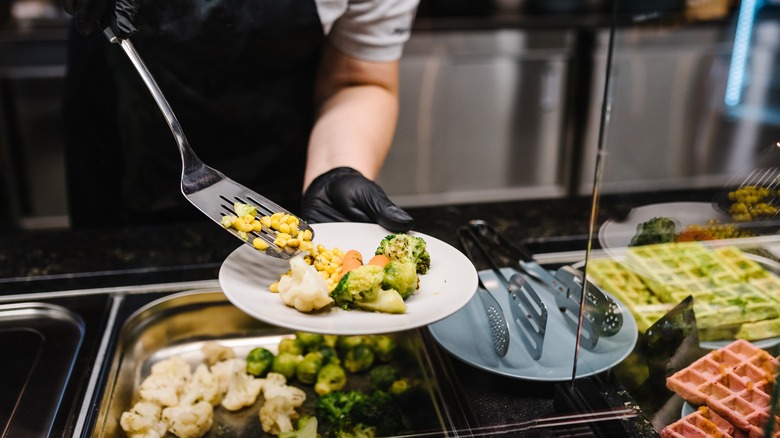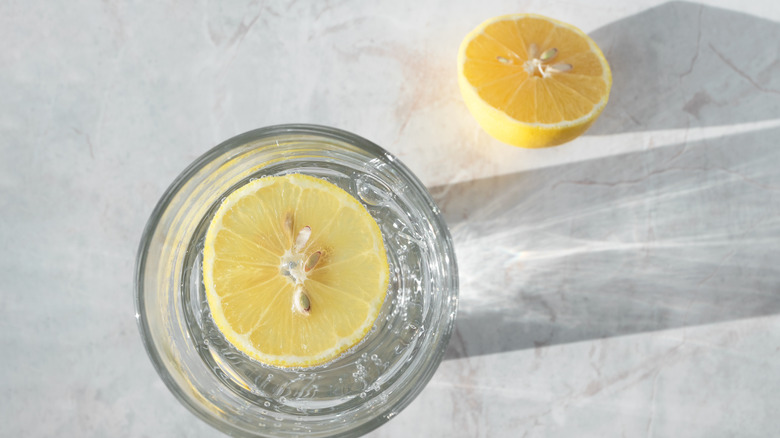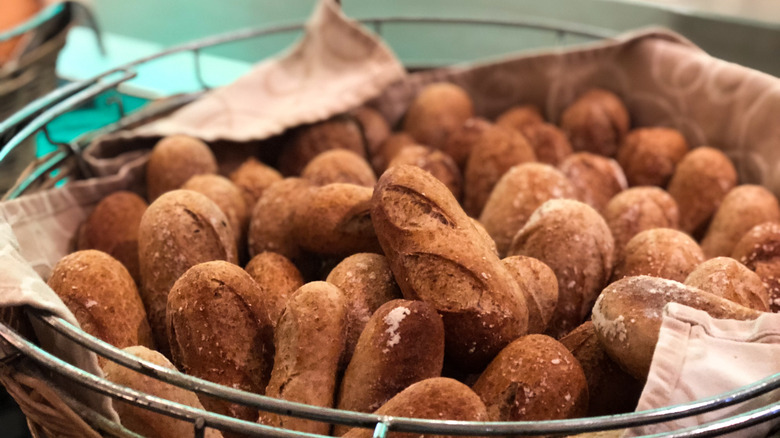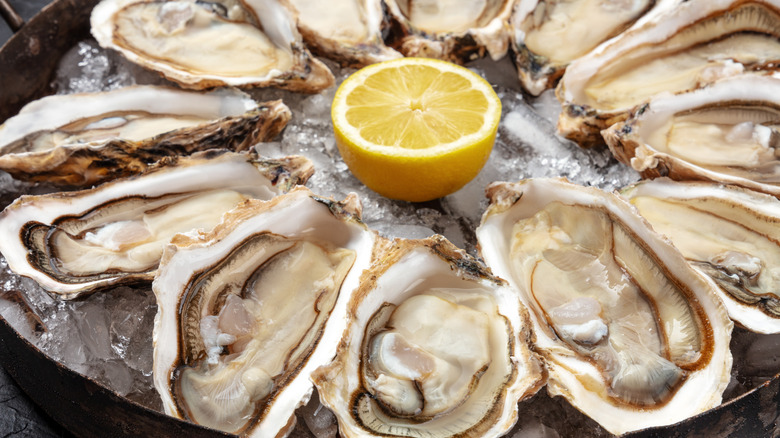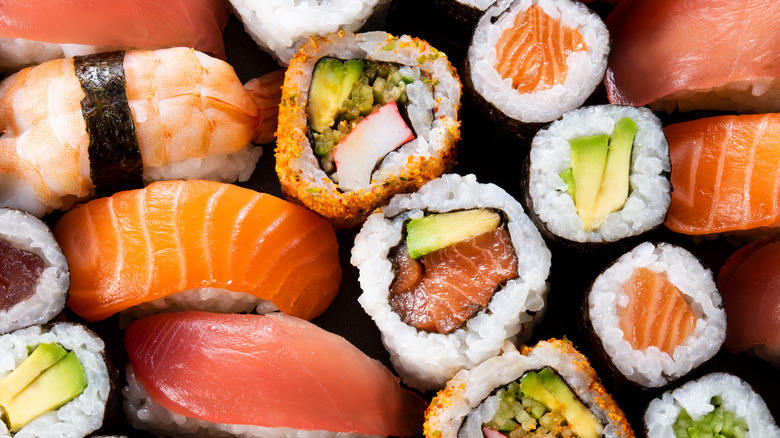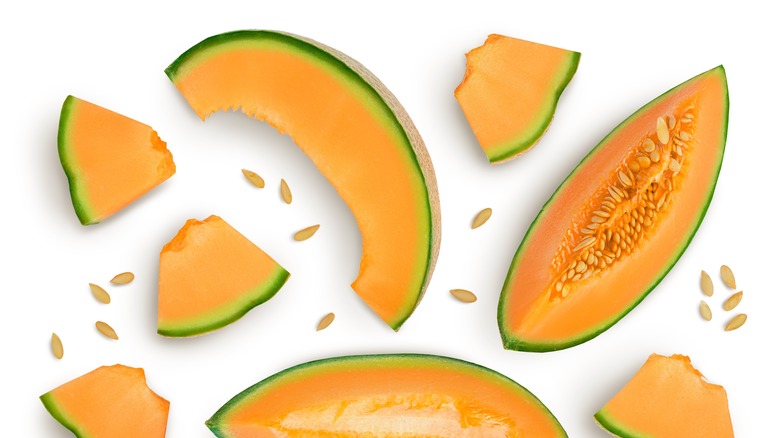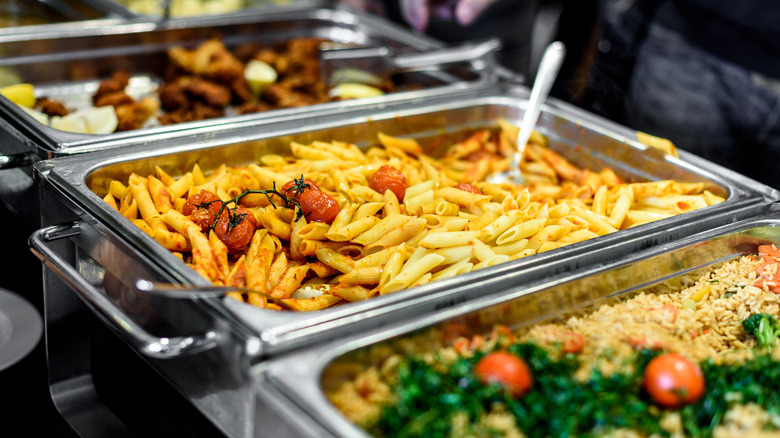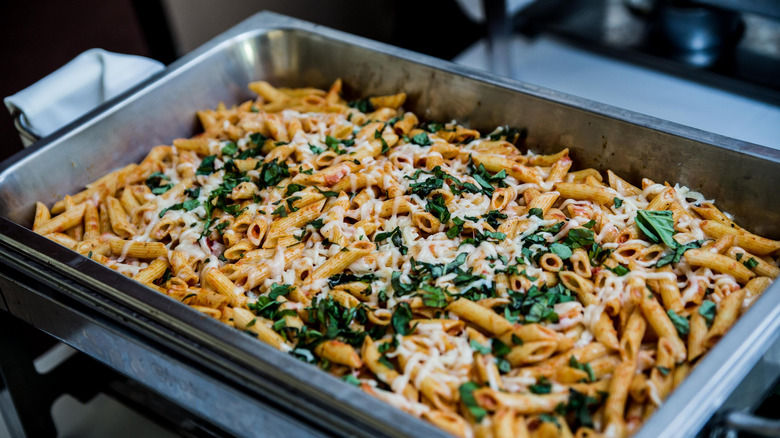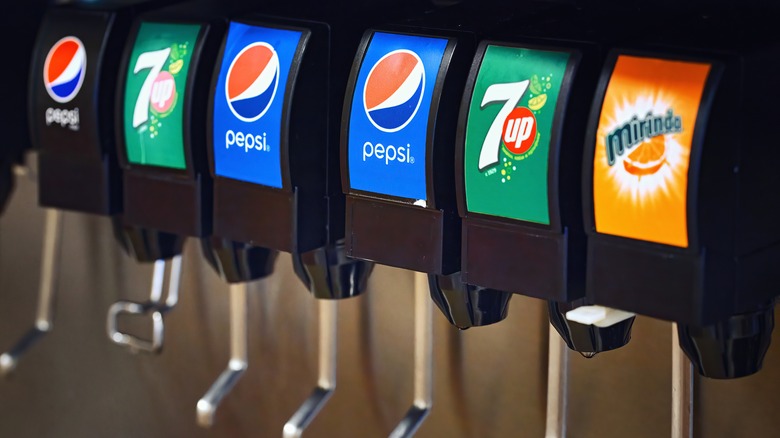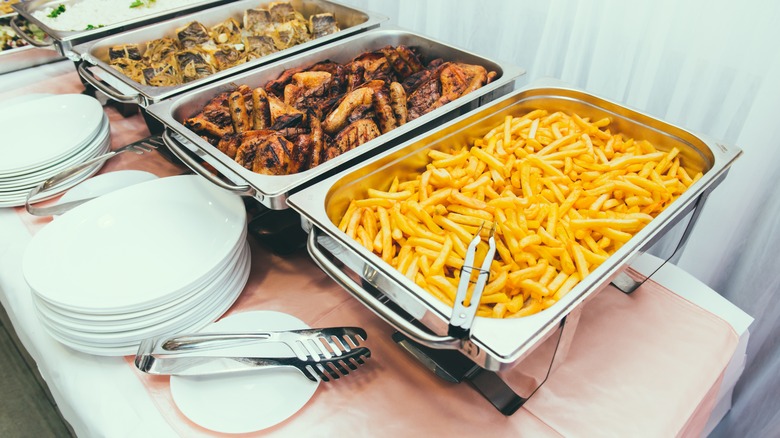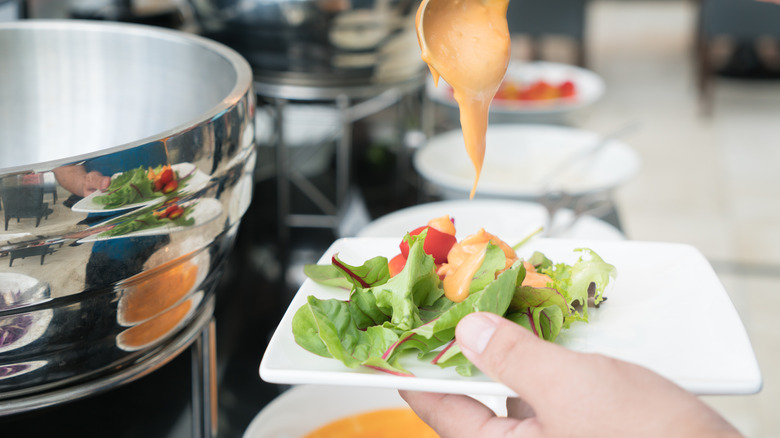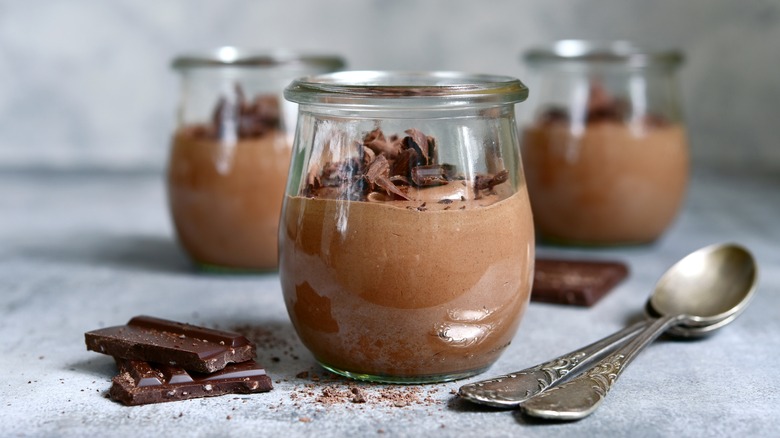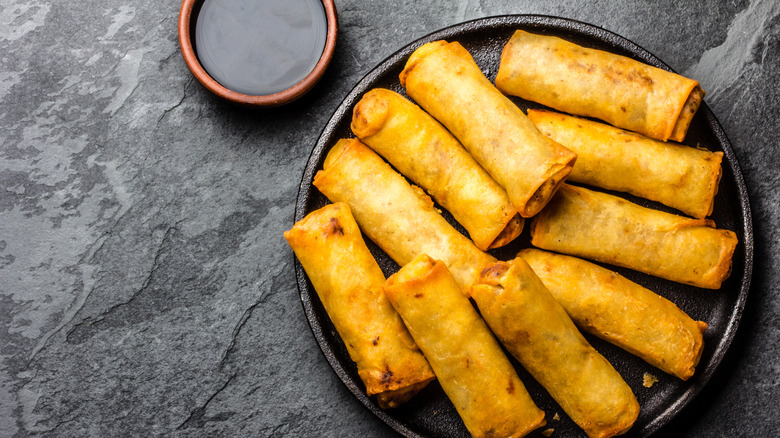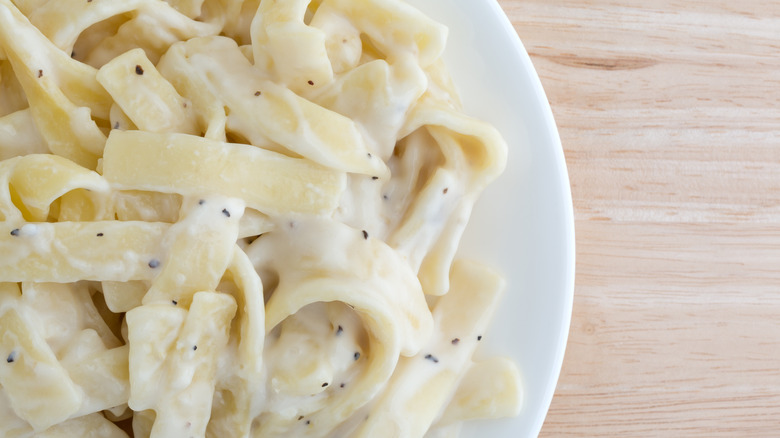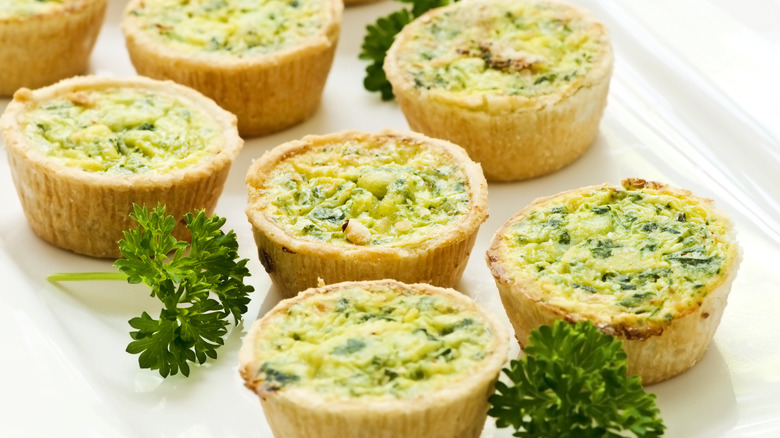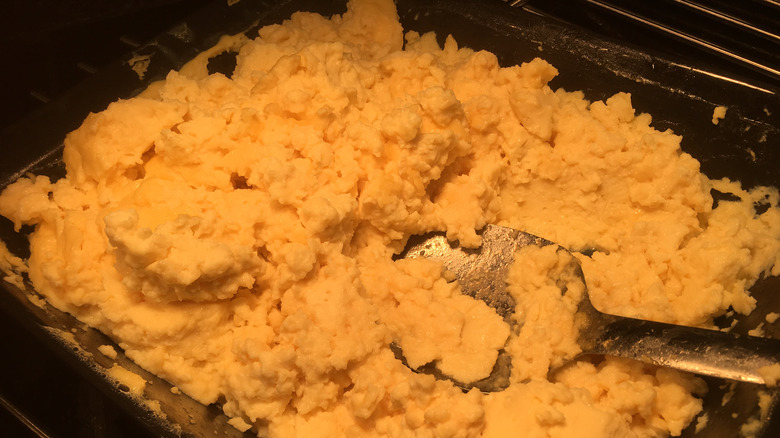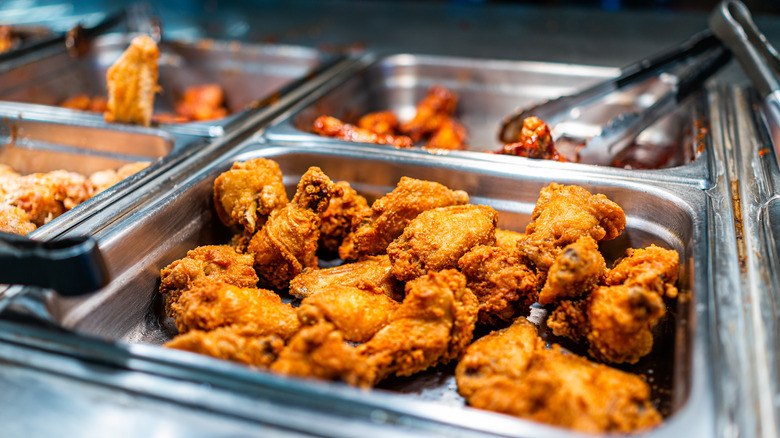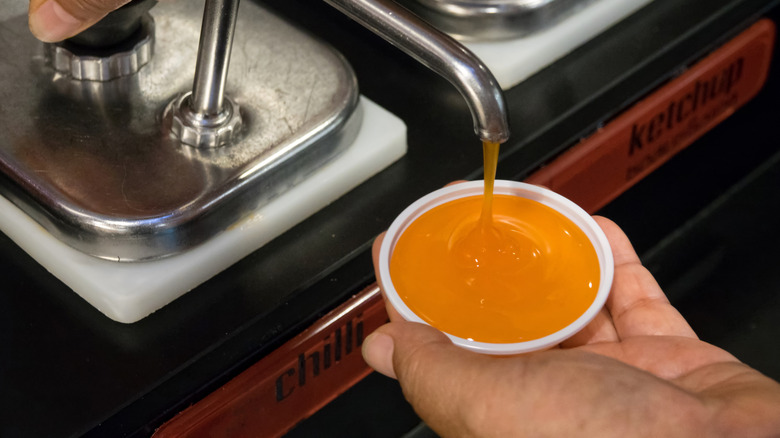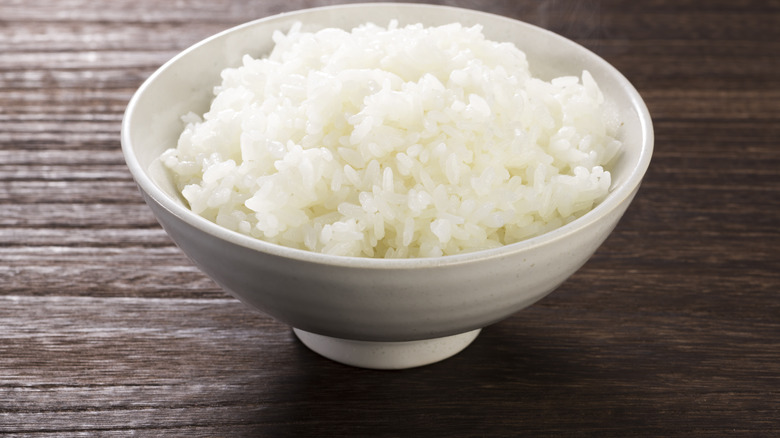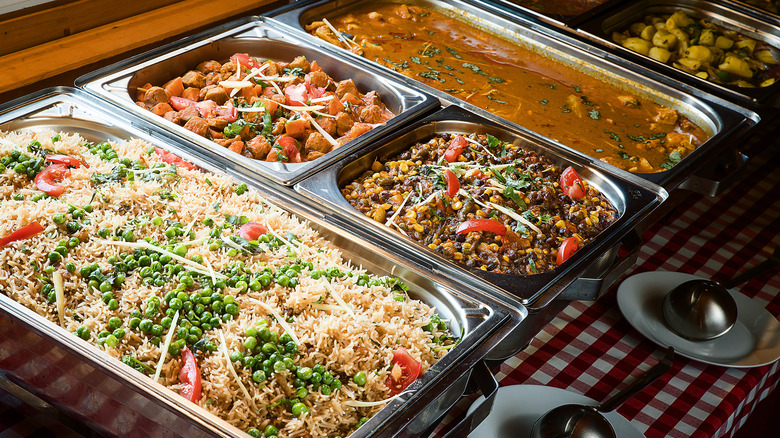20 Foods You Should Never Get From A Buffet
Buffets are a novel dining experience that few can confidently say are as enjoyable as they are cheap. The model of the buffet is simple — diners pay a set fee for as much food as they can eat and serve themselves as little or as much food as they want. Despite its practicality for folks with large appetites, Buffet-style dining has declined in popularity in recent years. This is linked to several important factors, including the rise of customizable, fast-causal meals at chains like Chipotle and the aging audience the buffet once targeted.
We would argue that one of the reasons folks are perturbed by the buffet, besides its copious amounts of food waste, is because of cleanliness. "Buffet" and "clean" are rarely used in the same sentence, simply because diners have to place some sense of trust in both the establishment, as well as in fellow diners to not cough all over the food. Even if you place a ton of faith in the safety of your buffet experience, there may be many pathogens and hidden dangers lurking in the hotel pans. Although there are always some exceptions to the rule, you should generally avoid eating these foods at a buffet.
20. Lemon slices or wedges
You might think a tiny lemon wedge is a refreshing citrusy addition to your water or Diet Coke. But it would be best if you never asked for a lemon slice in your drink. Past studies, such as one published by the National Environmental Health Association, have indicated that a high percentage of lemon rinds, flesh, or both contain some microbes that have the potential to cause disease. According to The Conversation, lemons can become contaminated when the lemon is sliced on a shared cutting board or using improper handling techniques.
Containers with self-serve lemon slices are even riskier since consumers may touch the slices with their dirty fingers and causing even more contamination risk. When you order your beverage, be sure to specify you do not want a lemon in your drink. You should also avoid raw lemon slices used as garnishes on buffet food.
19. Whatever is at the start of the buffet line
Buffets have figured out how to maximize their profits on buffet customers by placing filling, cheap foods like bread at the start of the line in the hope that customers will take more inexpensive items than the more expensive ones. According to one published research article, 75% of buffet diners studied chose the first item they saw at the buffet, while the first three foods the diners encountered accounted for around 66% of all of the foods they took.
In short, don't let yourself get tricked by the placement of foods at the buffet. Instead, take a few laps around before selecting food to get the most bang for your buck. You can also use smaller plates for bread to discourage you from grabbing too much of it.
18. Raw oysters
Raw food can be a dangerous choice at a buffet. Raw oysters, as appetizing as they can be, can pose serious health threats if improperly stored, cooled, and handled at a buffet. The Virginia Department of Health recommends individuals with compromised immune systems or certain pre-existing health conditions avoid the consumption of raw seafood like oysters and clams.
Oysters can become contaminated with Vibrio, norovirus, or hepatitis A via contact with contaminated water or transmitted by hands in the kitchen. Since oysters are eaten raw, there is no way to kill off these dangerous pathogens, which can cause gastrointestinal upset, weakness, skin rashes, or even death. It's best to go to a fishmonger or seafood restaurant to get your hands on some raw oysters.
17. Sushi
We're going to go out on a limb here and say that buffet sushi is normally less than stellar, so you're not missing much. But eating sushi (particularly any kind with raw fish involved) can increase your risk of contracting a foodborne illness. You shouldn't eat sushi at an all-you-can-eat buffet because of larval stage parasites like roundworms, tapeworms, and trematodes lurking in the fish flesh (via the FDA). Raw fish can also contain and transmit pathogens like listeria and anisakiasis (via UCMP HealthBeat).
If you are dead set on eating buffet sushi, you should always wash your hands before and after handling food and always use a fresh plate when going back for seconds. Eating sushi from a buffet may fill you up faster, too, since the rolls are generally filled with rice and filling fats like avocado.
16. Sliced cantaloupe
Cantaloupe is one of the major vectors of foodborne illness in the produce world. These fruits, especially ones that are pre-cut and served on buffets and in the prepackaged section of the grocery store, can carry salmonella bacteria and listeria. The hard ridges of these fruits harbor these pesky bacteria, which can come into contact with ready-to-eat pieces when the fruit is cut. Cut melons should always be kept refrigerated at temperatures below 41 F to slow the spread of bacteria and pathogens and maintain proper food safety.
You should avoid cantaloupe at the buffet because you can't be completely sure that the melon was scrubbed before cutting, nor that it was kept at a safe temperature. If you're craving fruit, it's best to stock up on safe fruits, like mandarin oranges, which are covered in a protective coating.
15. Foods that share a utensil
Cross-contamination is inevitable when you eat at a buffet, but to decrease your risk of illness, you should stick to eating foods that don't share a utensil. While there may be little risk of using the same utensil for sausage and bacon at a breakfast buffet, there are more risks when it comes to allergens and foods with residue. Before you scoop your roasted potatoes, check the spoon to see if there is residue from other foods. If there is, alert staff or management immediately so they can change the utensil.
The sheer risk of cross-contamination at a buffet — from either negligent patrons or inattentive staff, can pose a health risk to people with allergies or intolerances. If you have a dietary restriction, you should avoid buffets altogether and stick to restaurants better suited to your specific needs.
14. High-carb foods
Buffet management has your palate down to a monetized science. According to Marketplace, buffets often place foods high in carbs and low in cost towards the front of the buffet. Dishes like mashed potatoes, macaroni and cheese, and pasta may use larger serving spoons so that guests are easily tricked into eating more of the cheap food rather than the expensive options (which are often served on smaller plates or carved by a staff member to control the portions).
Marketplace recommends saving the starches for the end of the meal and taking small, controlled portions to make the most out of your buffet experience. You should also take a walk around the buffet before you pick what to put on your plate first.
13. Soda
There's a reason why buffets feature soft drink company logos on their beverage cups. Soda produces a tremendously high return for restaurants and buffets (since the syrup is so cheap to buy), and the hyper-palatable flavor causes customers to order refills throughout the duration of their meal.
Research published by the University of Southern California indicates that the sucrose in soda can cause a disruption in hunger-regulation hormones in the body and can cause you to crave and eat more of the cheap sweets and carbohydrate-rich foods at buffets. The carbonation in soda can also cause damage to your teeth and enamel erosion over time (via City Smiles St. Louis). We recommend sticking to water to save yourself a couple of extra bucks — and potentially a few dentist appointments in the long run.
12. Very salty foods
You are bound to be disappointed by soggy French fries at your local buffet — so that should be reason enough to avoid loading up your tray with salty, limp fries. But you should also avoid eating super salty foods if you want more food at the buffet. Scientific research by the journal Nutrients has indicated that consuming large qualities of salt stimulates thirst.
According to SFGate, increased water consumption may make you feel more full and cause you to eat less. If you want to eat more food, you should control your salt intake and stick to limited portions of french fries. If you are trying to avoid a high-sodium diet, you should avoid eating buffets altogether. The sauces, dressings, and entrees can hide a ton of sodium.
11. Dairy-based salad dressings
There's a reason why your thousand islands and ranch dressing needs to be kept in the refrigerator after opening. According to Eat Pallet, many commercial creamy dressings are made with preservatives that allow the dressings to be stored at room temperature for short periods of time. But, leaving creamy dressing out at room temperature for long periods can cause bacterial growth. Leaving open containers of salad dressing around is another risk at a buffet — since people can stick their fingers in the dressing, touch the serving utensil to their dirty plate, and similar offenses that can increase exposure to foodborne illness.
If you are looking to diminish your risk of contracting a foodborne illness, you should stick to acid-based salad dressings like vinaigrettes; the acid prohibits the growth and movement of bacteria, according to Nature.
10. Pudding and custards
Puddings and custards can be made with lightly-cooked or raw eggs, which can increase the risk of contracting foodborne illnesses like salmonella. When you're scooping custard or pudding from a buffet table, you might now know how well the eggs were cooked to make the dish. The FDA advises pregnant people, folks with compromised immune systems, and older adults to avoid consuming any dish that may contain undercooked eggs.
According to Eat Delights, puddings and custards made with eggs and milk should be kept refrigerated. Smarter Homemaker notes that cooked pudding should be left out at room temperature for no more than three hours. Some homemade ice creams can also be made with raw eggs, so it is best to avoid ice cream at buffets too.
9. Fried foods
Fried chicken that has sat under a heat lamp for a few hours? Not our cup of tea. Unless you go to a buffet immediately when it opens, you should avoid eating fried foods put out in the trays. The steam from the fried food condenses on the food and causes the coating to go limp and soggy. If the buffet makes the mistake of frying the food too hot, it can cause the food to soak up the oil before cooking — which means your fried egg rolls will taste soggy and grease-ladened. While there is a lower health risk of eating fried food than raw foods at a buffet, we doubt you'll be satisfied by the texture of what's in the tray. You should instead stick to grilled, baked, or steamed food.
8. Pasta with creamy sauce
Besides being a cheap, filling option at a buffet, you should never touch pasta with cream sauce for its numerous health implications. This dish pairs fattening sauces with carbohydrate-rich foods to fill patrons up before they have a chance to tackle the more expensive, high-value options at the buffet. Plus, creamy sauces tend to carry a greater food safety risk because the sauce is made with dairy products, which can spoil. Marinara sauce contains comparatively less fat than alfredo sauce and is more acidic, meaning it is less likely to harbor bacteria that can make you sick.
If you're getting pasta at a buffet, you can expect the noodles to be limp and nothing like your Italian nonna's Sunday pasta dinner. We recommend skipping the pasta to save yourself the disappointment.
7. Quiche or souffle
Cooked eggs can always carry a food safety risk if improperly stored. Cooked quiche can harbor E. coli bacteria, per research published in Communicable Diseases and Public Health, but the impacts of the hazard can be mediated by proper training and safe handling procedures. To ensure proper food safety, cooked egg casseroles must be cooked to a minimum internal temperature of 160 F (via the journal Foods).
Cooked egg dishes not eaten immediately need to be heated to 165 F before serving to ensure a diminished risk of salmonella — which is not ensured at a buffet. The bacteria growth is especially high at temperatures between 40 F and 140 F (via the FDA). Plus, if your quiche or souffle has been sitting out all day, we doubt the crust will be flaky anyway.
6. Scrambled eggs
Those scrambled eggs you eat at hotels and breakfast buffets might not be made with fresh eggs. Many buffets use powdered eggs, as shown in several behind-the-scenes Tik Tok videos (via Daily Dot). These powdered eggs are more shelf-stable than eggs and can be made in a shorter amount of time — which is perfect for a fast-service buffet. Powdered eggs have the same nutritional value as regular eggs but may have a slightly spongier texture than the freshly-cracked eggs you'd expect.
If you want fresh eggs, you should skip the powdered eggs — and if you have the option, go to the omelet station. You'll be able to see the eggs cracked in front of your eyes, and you won't have to worry about your eggs sitting out for a few hours.
5. Compromised foods
It should be common sense not to choose foods from a buffet tainted with, contaminated, or touched by other customers. Compromised food carries an immense biological risk, as customers can contaminate otherwise safe food with their germs. If you watch a customer dip below a sneeze guard to take a big whiff of fried chicken, you should probably avoid eating anything from that tray.
Likewise, if you see a customer breaking buffet etiquette and putting food back on a plate after they return for seconds, you should avoid eating from that tray and contact a staff member. Equally as important, you should practice proper diner etiquette at a buffet by washing your hands before and after you go to the buffet.
4. Communal condiments
If you've watched several people utilize a condiment station at any establishment — from gas stations to buffets — you could imagine the sheer number of hands and fingers that have touched the pumps and spouts. You should always ask for individually-packaged condiments if you're going to a buffet where the condiment station doesn't appear to get much staff attention. Latitude 365 Foods notes that using individually-packaged condiments can reduce food waste, too, since these packages are portioned controlled. You may have to ask the restaurant staff for these packets; the restaurant is most likely to have the condiments if it offers takeout options.
You should always wash your hands after you pump the condiments from the station. Or, try to use your elbow to pump the condiments onto your plate to minimize contact with your hands.
3. Old pizza
Does old pizza sitting for hours under a heat lamp make your stomach curl? If pizza isn't the most popular option at a buffet, you may notice the slices sitting out for long periods. After a while, the cheese will start to solidify on the crust and the sauce and render the slice hard rather than the plush, soft, cheesy piece of goodness we dream about. According to FitDay, pizza should be left out for no more than two hours before being thrown away. If the ambient temperature is 90 F, the pizza should be thrown out within an hour.
Adding pizza to a buffet comes with a strategy; cheap pizza with a dense, thick crust is a filling food for patrons. If you're craving pizza, we recommend going to a pizzeria — not a buffet.
2. Foods you can make at home
Eating out, as a concept, is all about being able to make foods you aren't able to make at home. So why would you go to a buffet to get the same pasta you make every Wednesday night — this time, just soggier? Our recommendation for buffets is to go big! Sticking to the most proteins you don't normally spring for at home will give you the best value for your buffet experience.
Salmon, crab legs, shrimp, and prime rib are usually tucked in the back of the buffet behind the cheaper items — but these foods are likely the ones you aren't making in your regular dinner rotation. If you consider yourself a "homebody" when it comes to food, try to push yourself to try at least one new food for each plate you take at the buffet.
1. Food prepared in large bins
If you're eating at a buffet, you should always try to eat the freshest food possible. At a busy buffet (or an understaffed one), you may notice that some foods are kept in very large trays rather than small compartments. This strategy is used to avoid refilling the trays throughout the service. Although this strategy might work well for the buffet's management, you're getting the older food that may have sat out for several hours before landing on your plate. A properly managed buffet has staff that swaps out the trays frequently for new ones — not just adds new food on top of the old food. While enjoying your first plate of food, keep an eye out for how frequently the management switches out the trays before you return for your next plate.
